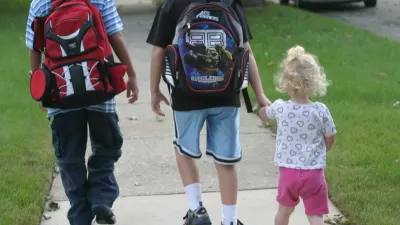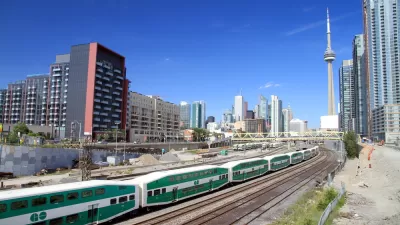For a while now, I've wondered if we have been mislabeling the development around well functioning transit stops as transit-oriented developments (TODs). This may seem odd, because numerous studies have shown that property values can increase by 20% to 40% percent around transit stops, particularly rail stations (although the increases are uneven).
For a while now, I've wondered if we have been mislabeling the development around well functioning transit stops as transit-oriented developments (TODs). This may seem odd, because numerous studies have shown that property values can increase by 20% to 40% percent around transit stops, particularly rail stations (although the increases are uneven).
The beginnings of my skepticism began when I started looking at transit ridership at these stations. For example, a quick look at boardings at Dallas light rail stations finds little, if any, relationship between transit ridership and investment around the station (see slide 7). A recent study (February 2011) of more than 200 TODs in California by the Public Policy Institute of California found no evidence that they boosted employment. (See also this study of Atlanta MARTA stations in the Journal of Urban Economics.) And, more tellingly, a survey of residents in Portland, Oregon by sociologist Bruce Podobnik at Lewis & Clark College found that residents of the New Urbanist TOD Orenco Station utilized transit more than conventional suburbs, but not any more than older Portland neighborhoods. In fact, most residents (two-thirds or more) continue to use their car to get to work rather than transit. Moreover, transit use has actually declined as a share of commuting trips in recent years (see Table 5).
So, what explains the increase in property values?
I believe it's the pedestrian access. The accessibility provided by density and mixed uses generates the value around these stations areas, not the transit access per se (and hence the mislabeling). In short, these stations areas are Pedestrian-Oriented Developments (PODs), not TODs. Indeed, Podobnik's survey of Orenco Station residents hints at this. In Table 5, 50 percent of survey respondents in Orenco said they walk to stores or shops five times a week or more (up from 11 percent five years earlier).
If I'm right, the implications are important for planning. While transit can't (and shouldn't) be dismissed, it's really a secondary component in making a vibrant urban place. Access from multiple transport modes (especially walking) to neighborhood services--from restaurants to shops to convenience stores to entertainment--is more important. Access is also important because most neighborhood businesses can't survive financially just on local patronage. So, planners need to consider access by all modes of transportation to make these areas work. Transit becomes important because the density and availability of neighborhood services makes it viable. In short, transit doesn't drive development, density and access does.
The implications also beg planners and researchers to begin really focusing on the differences in travel and trip behavior between transit, automobiles, walking, biking, and other travel modes. Too often, surveys lump alternative modes together. At the neighborhood level, big differences likely exist between walking and other modes even though they are obscured when the data are aggregated.
Of course, one of the problems we face now is that funding streams are generated around TODs, not PODs. In part, that's because funding is almost always linked to transportation funding, not access or urban character (and infrastructure needs) more generally. The next phase, particularly for state and local governments, is to think in terms of shifting infrastructure funding programs to consider broader and more integrated approaches that are less modally oriented and more geographically oriented.

Planetizen Federal Action Tracker
A weekly monitor of how Trump’s orders and actions are impacting planners and planning in America.

Maui's Vacation Rental Debate Turns Ugly
Verbal attacks, misinformation campaigns and fistfights plague a high-stakes debate to convert thousands of vacation rentals into long-term housing.

San Francisco Suspends Traffic Calming Amidst Record Deaths
Citing “a challenging fiscal landscape,” the city will cease the program on the heels of 42 traffic deaths, including 24 pedestrians.

Defunct Pittsburgh Power Plant to Become Residential Tower
A decommissioned steam heat plant will be redeveloped into almost 100 affordable housing units.

Trump Prompts Restructuring of Transportation Research Board in “Unprecedented Overreach”
The TRB has eliminated more than half of its committees including those focused on climate, equity, and cities.

Amtrak Rolls Out New Orleans to Alabama “Mardi Gras” Train
The new service will operate morning and evening departures between Mobile and New Orleans.
Urban Design for Planners 1: Software Tools
This six-course series explores essential urban design concepts using open source software and equips planners with the tools they need to participate fully in the urban design process.
Planning for Universal Design
Learn the tools for implementing Universal Design in planning regulations.
Heyer Gruel & Associates PA
JM Goldson LLC
Custer County Colorado
City of Camden Redevelopment Agency
City of Astoria
Transportation Research & Education Center (TREC) at Portland State University
Jefferson Parish Government
Camden Redevelopment Agency
City of Claremont






























